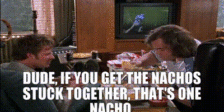
Have you ever clicked on Word or Excel or some other program that you need to work in, only to discover that it’s already open because you were working in it an hour or so ago and then got distracted and abandoned that task, your spreadsheet getting buried under all sorts of other documents, windows, and tabs that are sparklier and more interesting?
Me neither. (Hahaha, I’m hilarious.)
Last year, I posted “give up multi-tasking” as something to stop doing in order to be successful.
And I still believe it. But it’s HARD.
Here’s the thing about multi-tasking: I’m pretty sure I didn’t get a job offer (that I really, really wanted) based on my smart-alecky response to a question about multi-tasking. It was many years ago, but even then, I couldn’t bring myself to say, “Yes, I can multi-task, and I am SO GOOD at it!” Because I know that I cannot multi-task and expect any of the things I’m doing simultaneously to be of high quality.
My response in the job interview was something about not believing in multi-tasking, but instead being a really good switch-tasker, in that I can focus on one thing, get interrupted, and change gears really quickly to focus on something else.
But guess what? Switch-tasking is just a sneaky word for multi-tasking. And I was too naive to understand that. (Maybe that’s the real reason I didn’t get the offer.) The start/stop/start process with switch-tasking takes a serious toll: one study found that it takes over 23 minutes to re-focus on the primary task after an interruption (or series of interruptions). 23 minutes!
When I think about interruptions throughout my day, there are far fewer external ones, like coworkers popping into my office to ask a quick question, than internal ones, where, in the middle of writing an email, I suddenly decide that I NEED to check the weather or look up how many songs Neil Diamond wrote for other artists.
So, single-tasking?
Since there’s not a ton of mindfulness involved in my self-interruptions, I need a constant reminder to single-task instead. Sometimes, when I embark on a task, I’ll write it on a pad of paper right next to me. It serves as a visual reminder of the task (literally) at-hand. When it’s done, I cross it off and write down the next task. And when I think of something in the middle of a task I’m working on, I write it down on that same pad of paper and get back to work on the original thing. Yes, that’s an interruption too, but it’s much better than shifting my focus to the shiny new task that popped into my head and could derail me for who knows how long.
But nobody’s perfect.
Presenting: sandwich-tasking!
On my journey to single-tasking utopia, I’ve done a bit of a bunny hop. Instead of thinking of something else mid-task, writing it down, and going back to that first task, what usually ends up happening is I think of that new task and switch to it. And this could happen over and over again until I’m eight tasks away from the first one, and none of them are finished.
When I first discovered this pattern, I thought, “I know! I’ll make a rule that when I catch myself switch-tasking, I have to go back to the original task and finish it before I go back to the new one.” But then I realized that that’s interrupting two tasks—the original and the new one—instead of just the first task. So now, the rule is: when I catch myself switch-tasking, I HAVE to complete the new task before I switch back to the original. If the original task wasn’t written down, I write it down because I can easily lose sight of what it was when I finish the new task.
It’s still switch-tasking, sure. But now, I can make a complete task sandwich (with the bread being Task A and the insides being Task B) instead of an infinitely-layered open-faced task sandwich.
Now. Who’s ready for lunch?





One Reply to “The case for sandwich-tasking”